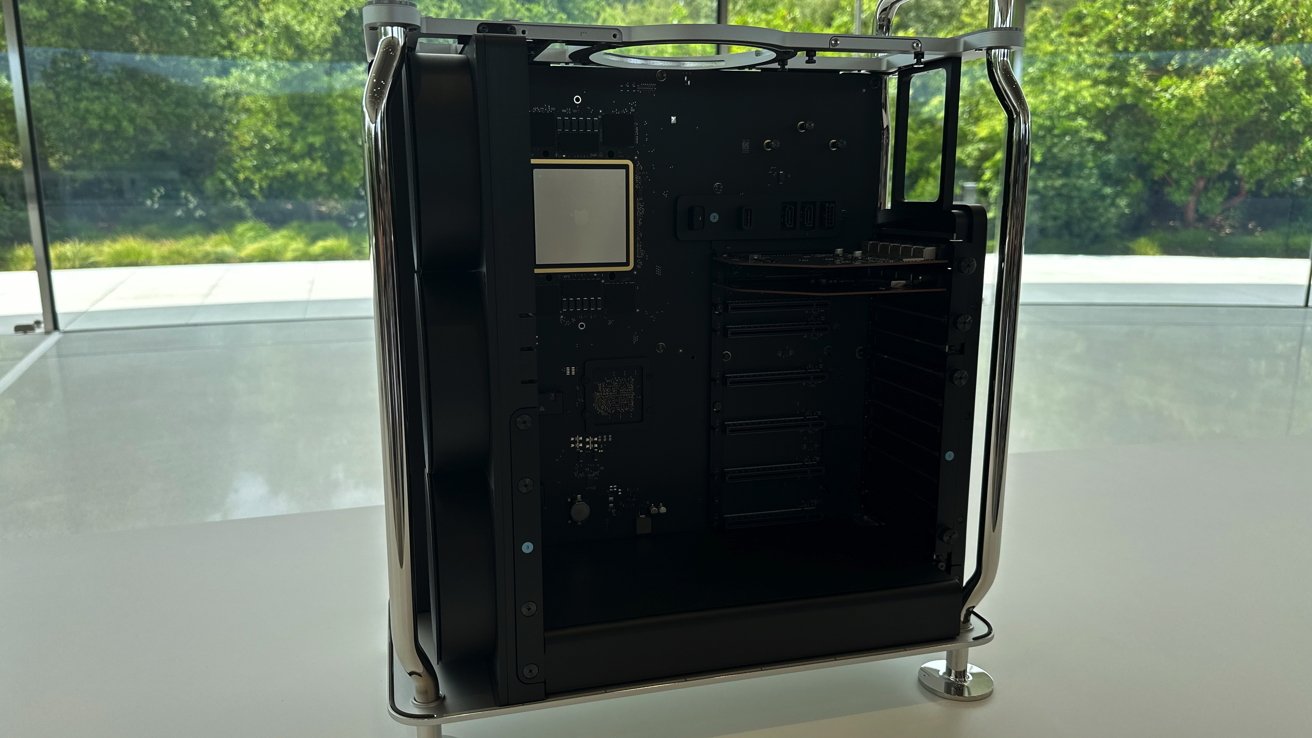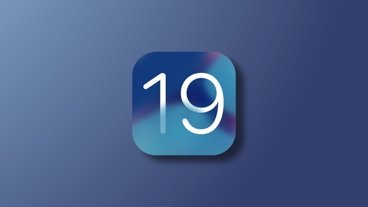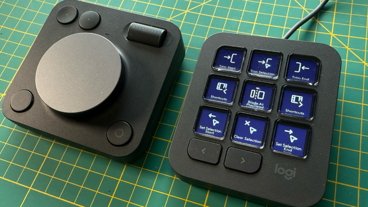The Apple Silicon Mac Pro is here two and a half years after the shift from Intel began, but it looks like the company only did it to say that they had.
So, it's been a few days since the omnibus Apple WWDC keynote. Just about every year, there are rumors that a wide swathe of Apple's product line — particularly Macs — will get updated.
This was the first year in a long time that happened. But, those announcements were little more than a preamble to the Apple Vision Pro announcement.
Right after the consumer-focused 15-inch MacBook Air, and the "pro"-centric Mac Studio, Apple announced the end of the shift to Apple Silicon in the new Mac Pro.
What we got from the Apple Silicon Mac Pro, in summary, was this.
- M2 Ultra processor, promised to be fast and well-cooled
- Soldered-in 64 GB of RAM, with the max at 192GB
- Vague promises about the equivalent of seven Afterburner cards on the chip
- 1TB of SSD space, with up to 8TB available through Apple
- Six full-length PCI-E fourth generation slots
- Wi-fi 6E
- More expensive wheels
- And it's quieter than the Intel version
And all this for $6999, $1000 more than the Intel version.
Gone this year is the upgradeable RAM. And, the maximum amount of RAM is less. But don't worry — Apple says it's enough to run large language models if you max it out at the time of purchase.
Also gone is the ability to support Radeon PCI-E video cards, and that's a baffling removal. Apple doesn't even have MPX modules for it, and even that slot is gone.
As it stands, the M2 Ultra processor in the core Apple Silicon Mac Pro will deliver right around 185,000 on Geekbench 6, based on extrapolation from Apple's tech specs for the chip with a bonus for better cooling. That puts it right around the AMD Radeon Pro W6800X.
And, it, and the Mac Studio for half the price, will only ever deliver just that. There's no way to get better Metal performance with an add-on.
It also puts it far lower than the Radeon RX 6900XT that's available at retail. That delivers about 230,000 on Geekbench 6. Intel Mac Pro tower owners can jam four of these cards in, with slower PCI-E slots to spare.
The up-gunned Mac Pro looks like it will deliver about 215,000 on Geekbench's Metal testing. That's still less than the Radeon PCI-E card in a PCI-E 3.0 slot in the Intel Mac Pro.
The reasons why for this are complex. It's not just about drivers — Apple has decided that it didn't need a way for the Apple Silicon processor to talk to an external graphics card, at all, under any circumstances.
It seems unlikely that they'll retrofit this.
What the Pros think
I've spent a few days talking to my contacts across a few industries. Nobody's really impressed.
The music industry folks I talked to are mostly sticking with their 2019 Mac Pro, and a few stalwarts are hanging on to their 5,1 Mac Pro towers for a few more years. The ancient Mac Pros in the studio or on the road don't connect to the internet, so they're not too worried about a lack of security updates.
My Department of Defense folks that used to use Mac Pros are using the Mac Studio now for the most part, with a PCI-E breakout box or two. They have no intentions of shifting, even though they effectively have a spigot of hot and cold running cash to draw from for research or projects.
In every case, the lack of PCI-E GPU support is the killing factor for the new Mac Pro for these folks that all have buckets of money to throw at a problem, if the lack of upgradeable RAM didn't turn them off before they got there.
No video cards, but still PCI-E
Like I said earlier, if you had one of those MPX modules for increased storage, that's too bad. You're out of luck.
There is still a need for PCI-E cards in media production. There are capture cards for many source of audio or video, there are cards for more storage, more USB, and so much more.
The Intel Mac pro is being used by music producers, I've seen it backstage at shows of all kinds. There's a need for it in science of all aspects, and so forth. Obviously, think massive calculational loads, not emails or surfing-primary users unless for a fashion statement.
But today, there are better options. I'm in the process of wrapping up a review of a Sonnet rack-mount for a Mac Studio, which is oddly prescient. The xMac Studio Pro will, for about $1100, hold a Mac Studio for $1999 or $3499 at full retail, depending on processor, and allow for a PCI-E card.
There's also Sonnet's DuoModo system that we've reviewed before, that can provide three PCI-E cards in one enclosure. Alternatively, that old Thunderbolt eGPU enclosure that Apple said in 2016 was the future can handle any of these cards as well, albeit with a 32 gigabit per second cap, versus up to eight times that on a x16 fourth-generation PCI-E slot.
And, all of this, even with a M2 Ultra Mac Studio, still comes in well under the price of the core Mac Pro.
Apple Silicon is great, but the Mac Pro with it is not
Apple Silicon has been great for Apple, and the Mac faithful. It's got industry-leading computing grunt to power consumption, and it does it all quietly and in a very cool package. No more lap-singeing MacBook Pros!
It's restored pricing at the low-end that hasn't been seen in a long time. It's also broken the shackles of promises Intel made for years that led to engineering choices that couldn't handle the heat as well as they should have been able to when the chips that fell short of those lofty goals were delivered.
The Mac Studio and M2 Pro Mac mini are amazing machines. They're both powerful and reasonably affordable for the market segment that needs them. The 14- and 16-inch MacBook Pro are some of the best portable Macs ever made — but I will admit still having a soft spot for my PowerBook 540c to this day.
The Apple Silicon Mac Pro falls short of these lofty heights. It's not close.
As it stands, it is a computing appliance. A set-and-forget computer is fine for most of the Mac-using public, but it is very not fine for the target market for this computer.
Apple once had a Pro-centric team that it consulted for the iMac Pro, and it used them again for the Mac Pro reboot in 2019. I don't think that they talked to them at all for the new one, based on what Apple released.
Maybe that focus group will get together for a M3 or M4 Ultra Mac Pro. But, I'm not holding my breath.
 Mike Wuerthele
Mike Wuerthele-xl.jpg)










-m.jpg)






 Christine McKee
Christine McKee
 Malcolm Owen
Malcolm Owen
 Marko Zivkovic
Marko Zivkovic

 Andrew Orr
Andrew Orr
 Andrew O'Hara
Andrew O'Hara
 William Gallagher
William Gallagher





-m.jpg)



71 Comments
I think the Mac Studio is enough for a lot of previous Mac Pro buyers who needed the power but not the extendibility of the past Mac Pro, reducing the need for an extensible Mac Pro. In addition, the new SoC approach of Apple Silicon does not allow it to extend memory, which is probably a must have for buyers of this kind of machines. Because of this, I am a bit surprised Apple came with a new Mac Pro. This is not a Mac Pro in the same sense the previous one was.
I'm getting 192,834 on Geekbench 6.0.3 metal with my 2017 iMac Pro with a TB3-based Sonnettech eGPU with a Radeon RX 6900 XT. It's disappointing that the M2 Ultra apparently can't even reach that number!
I’m curious how you’re fitting four 6900’s in the Mac Pro. I was only able to get two. Any examples?
I think Apple has once again drawn a line in the sand
making it clear they are OK with true power users having to use PC’s. Apple is just bored by and unserious about truly high end computing. I’m guessing they are OK with folks with extreme use cases moving to commodity Windows machines.
Could you explain the statement "The reasons why for this are complex. It's not just about drivers -- Apple has decided that it didn't need a way for the Apple Silicon processor to talk to an external graphics card, at all, under any circumstances."? If my 6-year-old Intel iMac Pro can talk to a graphics card over Thunderbolt 3, why can't an Apple Silicon-based Mac do the same? I think it IS about drivers, and the fact that Apple doesn't want to work with either AMD or nVidia ever again. https://machow2.com/m1-mac-egpus/
I don't understand why MPX got dropped. It seemed a pretty neat form factor, and wasn't only being used for GPUs. The new Mac Pro supposedly has the exact same PSU and fans arrangement, so it's not as if there wasn't the capacity there.